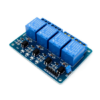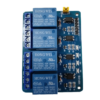4 Channel Relay Module (with light coupling) 5V
In stock
- Operating Voltage: 12V DC
- Equipped with high-current relay 10A@250VAC / 10A@30VDC
- It can control both AC and DC appliances such as Solenoids, Motors, lights, fans, etc
- High-quality screw terminals (Terminal Block) provided (C, NC, NO) for quick and easy connection
- Freewheeling diode to protect your microcontroller
- Input Signal Pin connected to Burg stick for easy accessibility
- LED Status indicators to indicate the relay ON/OFF status
- Mounting holes provided
₹170.00 ₹199.00 (Price Excl. GST) ₹144.07
In stock
CompareThis 4 Channel Relay Module (with light coupling) 12V module meets the safety standard as control areas and load areas have the isolation groove. Optical coupling isolation module. The triggering of the 4 Road/Channel Relay Module is reliable and more stable. The double FR–4 circuit board design, high-end SMT process. It has power and relay operation instructions. Relays terminals (C, NC, NO) are accessible through screw terminals which makes wiring up the board very easy.
The inputs of the 4 Channel 12V Relay Module are isolated to protect any delicate control circuitry. A wide range of microcontrollers such as Arduino, AVR, PIC, ARM, and so on can control it. The use of such a high-voltage relay eliminates the risk of heating the relay as electromechanical relays limit the current consumption by a voltage rating.
The 4-channel Relay Module with Light Coupling, operating at 5 volts, stands as a fundamental component in various automation and control systems. Designed to facilitate the interaction between low-voltage digital circuits and high-power electrical appliances, this module provides users with the ability to control up to four independent circuits simultaneously. Equipped with light coupling technology, it ensures reliable and safe operation by isolating the control signals from the load circuits, thereby protecting sensitive electronics from potential voltage spikes and interference.
At its core, the relay module serves as an interface between microcontrollers, such as Arduino or Raspberry Pi, and a range of high-power devices including lights, motors, solenoids, and more. Its four-channel configuration offers versatility in system design, allowing users to control multiple electrical loads with ease. This capability is particularly valuable in applications such as home automation, industrial control, robotics, and DIY electronics projects, where the need for multi-channel control is prevalent.
The integration of light coupling technology enhances the reliability and safety of the relay module. Light coupling, also known as optocoupling or opto-isolation, employs optocouplers to electrically isolate the input and output sides of the circuit. This isolation prevents electrical disturbances from affecting the control circuitry, reducing the risk of damage to sensitive components and ensuring reliable operation in noisy environments. By incorporating light coupling technology, the relay module offers an added layer of protection, making it suitable for a wide range of applications where reliability is paramount.
Furthermore, the relay module features high-quality relays capable of handling significant currents and voltages. Each of the four channels typically employs a relay with multiple switching contacts, allowing users to control different types of loads, including both AC and DC loads. This versatility enables the module to accommodate various devices and applications, from simple lighting control to motor direction control and power distribution in industrial settings.
The module’s design includes status indicator LEDs for each channel, providing visual feedback on the relay’s operational status. These LEDs illuminate to indicate whether the associated circuit is energized (closed) or de-energized (open), aiding in troubleshooting and system monitoring. Additionally, the module often features screw terminals or pin headers for easy and secure connections, simplifying installation and integration into electronic projects.
Interfacing the relay module with microcontrollers or digital systems typically involves sending simple control signals, such as digital HIGH (logic 1) and LOW (logic 0) signals, to trigger the relays. This straightforward interface makes it easy to incorporate the module into existing projects or control systems, requiring minimal programming or configuration.
In summary, the 4-Channel Relay Module with Light Coupling at 5 volts offers a reliable and versatile solution for controlling high-power electrical devices in a variety of applications. With its multi-channel design, light coupling technology, high-quality relays, status indicator LEDs, and user-friendly interface, this module provides users with the flexibility, safety, and convenience required for automation, control, and prototyping projects. Whether used in home automation, industrial control, robotics, or DIY electronics, this relay module serves as an essential component in modern electronic systems.
Meaning of High-level and Low-level
- High-level trigger refers to using the anode voltage at the VCC connection way of a trigger and triggers the end when the trigger side has the positive voltage or to trigger voltage when the relay is off.
- Low-level trigger refers to using the negative voltage at the GND connection way of a trigger and triggers the end when the trigger side has 0 v low voltage or voltage to can trigger, the relay is off.
Note: The available relay module types are: JQC-3FF-S-Z, JQC3F-12VDC-C, and FL-3FF-S-Z. You may get any of it randomly.
Features :
- Equipped with high-current relay 10A@250VAC / 10A@30VDC
- It can control both AC and DC appliances such as Solenoids, Motors, lights, fans, etc
- High-quality screw terminals (Terminal Block) provided (C, NC, NO) for quick and easy connection
- Freewheeling diode to protect your microcontroller
- Input Signal Pin connected to Burg stick for easy accessibility
- LED Status indicators to indicate the relay ON/OFF status
- Mounting holes provided
- Signal input with a high-level signal, the common and often start conduction;
- The relay can directly control all kinds of equipment and load;
- One often opened a normally closed contact;
- The Blue KF301 terminal line is more convenient.
Package includes :
1 x 4 Road/Channel Relay Module (with light coupling) 12V
Specifications
| Channel | 4 |
| Trigger Voltage (VDC) | 12 |
| Trigger Current (mA) | 20 |
| Switching Voltage (VAC) | 250@10A |
| Switching Voltage (VDC) | 30@10A |
| Mounting hole dimensions | Diameter=3mm, X-axis pitch=68mm Y-axis pitch=48mm |
| Length (mm) | 75.5 |
| Width (mm) | 55.5 |
| Height (mm) | 20 |
| Weight (gm) | 58 |
| Shipment Weight | 0.059 kg |
Shipping & Returns
Due to the type of products we sell, we accept limited returns. Below are the conditions where we can accept a return request.
MANUFACTURING DEFECT
If you receive a product with a manufacturing defect, please notify us within 1 day of receiving the product, supported by the proper pictures and description. Once our support team accept the return, we will provide a replacement or a complete refund including the return shipping cost.
WRONG ITEM SHIPPED
If you receive a different product than the ordered one, please contact us within 1 day of receiving the product, supported by the proper pictures and description. Once our support team accept the return, we will provide a replacement or a complete refund including the return shipping cost.
LIMITATION OF RETURNS
We don’t accept returns for products damaged by improper use of the product. Moreover, we don’t accept the return if the ordered product is unsuitable for any specific application. Please read the product specifications and datasheet before selecting and ordering a product.
WHAT VOID WARRANTY?
If the product is subject to misuse, tampering, static discharge, accident, water or fire damage, use of chemicals & soldered or altered in any way.
SHIPPING
We ship all over India. Please contact our support team at info@inventkart.com for any questions related to shipping.
Based on 0 reviews
Be the first to review “4 Channel Relay Module (with light coupling) 5V”
You must be logged in to post a review.












There are no reviews yet.